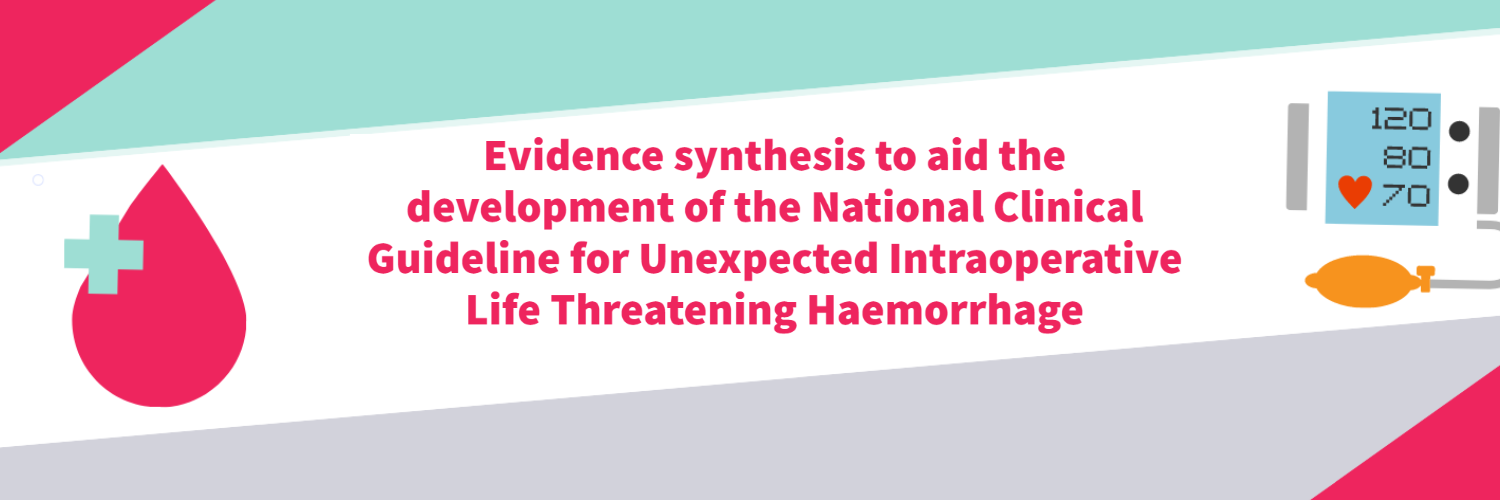Unexpected Intraoperative Life Threatening Haemorrhage National Clinical Guideline

The National Clinical Effectiveness Committee (NCEC) requires consideration of evidence on both the clinical and cost-effectiveness of guideline recommendations in the development of all National Clinical Guidelines (NCGs) in Ireland. The completion of a budget impact analysis (BIA) based on implementation of the NCG is also required. The role of the HRB-CICER Team is to independently review the evidence and provide scientific and methodological support in the development, by the Guideline Development Group (GDG), of these evidence-based NCGs.
The NCG for Unexpected Intraoperative Life Threatening Haemorrhage has been developed to provide clinical staff with evidence based actions to assist with preventing, recognising, managing and responding to an unexpected life threatening haemorrhage that occurs during a surgical operation.
To support the development of the NCG, the HRB-CICER Team conducted the following:
- a systematic review to identify and appraise clinical guidelines, relevant to the management of life threatening haemorrhage
- a systematic review to summarise evidence relating to the incidence of intraoperative life threatening haemorrhage, and associated mortality, in Ireland
- a BIA to quantify the cost and resource implications to the Health Service Executive, following implementation of the NCG.
Following a significant patient safety event, the NCEC was requested by the Minister for Health to commission this NCG. Prior to the publication of this guideline, no national guidance on strategies and pathways for the prevention, recognition or management of life threatening haemorrhages, which occur intraoperatively, existed in Ireland.
The aim of the first systematic review undertaken by HRB-CICER was to identify and appraise clinical guidelines, relevant to the management of life threatening haemorrhage, and find out if there were any existing high-quality guidelines that could be adopted or adapted for the Irish setting, or if de novo development was required. No guideline was identified which addressed the management of intraoperative life threatening haemorrhage as the primary topic.
The aim of the second systematic review was to summarise evidence relating to the incidence of intraoperative life threatening haemorrhage, and associated mortality, in Ireland. Three single institution studies met the inclusion criteria and provided limited data relating to intraoperative life threatening haemorrhage and associated mortality from specific surgical procedures at a local level. As no sources of population-level data were identified, the incidence of intraoperative life threatening haemorrhage and associated mortality in Ireland could not be determined.
The BIA aimed to quantify the cost and resource implications of implementing the guideline recommendations. Based on the NCG recommendations and implementation plan, the resource implications were:
- additional medical scientists to provide cover to enable the large number of medical sientists who support out of hours in the transfusion laboratory (but who do not routinely work there) to complete the recommended ten days familiarisation each year
- introduction of training in recognising, responding to and managing major blood loss for all theatre staff and transfusion laboratory staff (including those providing out of hours cover)
- the introduction of Overarching Transfusion Committees to review and benchmark unexpected life threatening haemorrhage events including overall trends, outcomes and processes
- production of a National Life Threatening Haemorrhage Management Poster to be displayed in all operating theatres to assist with responding to a life threatening haemorrhage event.
The systematic reviews adhered to the Preferred Reporting Items for Systematic Reviews and Meta-Analyses (PRISMA) criteria.ǂ
The budget impact analysis was conducted in accordance with the HIQA guidelines for budget impact analysis and economic evaluation in Ireland.
ǂ Available at PRISMA (prisma-statement.org)